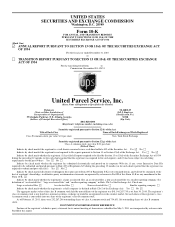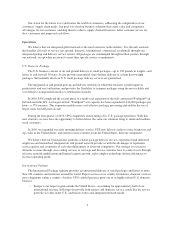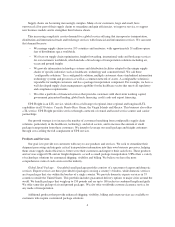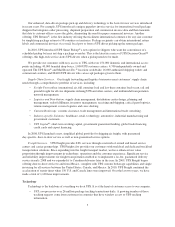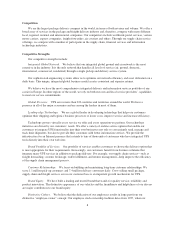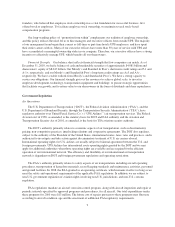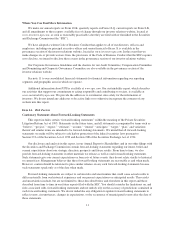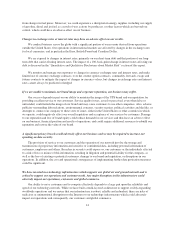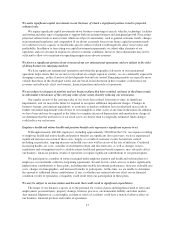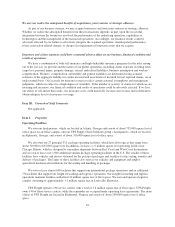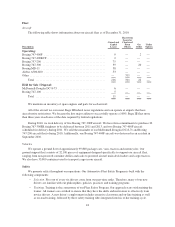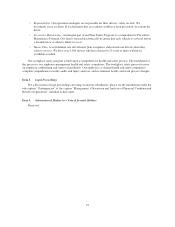UPS 2010 Annual Report Download - page 21
Download and view the complete annual report
Please find page 21 of the 2010 UPS annual report below. You can navigate through the pages in the report by either clicking on the pages listed below, or by using the keyword search tool below to find specific information within the annual report.founders, who believed that employee stock ownership was a vital foundation for successful business, first
offered stock to employees. To facilitate employee stock ownership, we maintain several stock-based
compensation programs.
Our long-standing policy of “promotion from within” complements our tradition of employee ownership,
and this policy reduces the need for us to hire managers and executive officers from outside UPS. The majority
of our management team began their careers as full-time or part-time hourly UPS employees, and have spent
their entire careers with us. Many of our executive officers have more than 30 years of service with UPS and
have accumulated a meaningful ownership stake in our company. Therefore, our executive officers have a strong
incentive to effectively manage UPS, which benefits all our shareowners.
Financial Strength. Our balance sheet reflects financial strength that few companies can match. As of
December 31, 2010, we had a balance of cash and marketable securities of approximately $4.081 billion and
shareowners’ equity of $8.047 billion. Our Moody’s and Standard & Poor’s short-term credit ratings are P-1 and
A-1+, respectively, and our Moody’s and Standard & Poor’s long-term credit ratings are Aa3 and AA-,
respectively. We have a stable outlook from Moody’s and Standard & Poor’s. We have a strong capacity to
service our obligations. Our financial strength gives us the resources to achieve global scale; to invest in
employee development, technology, transportation equipment and buildings; to pursue strategic opportunities
that facilitate our growth; and to return value to our shareowners in the form of dividends and share repurchases.
Government Regulation
Air Operations
The U.S. Department of Transportation (“DOT”), the Federal Aviation Administration (“FAA”), and the
U.S. Department of Homeland Security, through the Transportation Security Administration (“TSA”), have
regulatory authority over United Parcel Service Co.’s (“UPS Airlines’”) air transportation services. The Federal
Aviation Act of 1958, as amended, is the statutory basis for DOT and FAA authority and the Aviation and
Transportation Security Act of 2001, as amended, is the basis for TSA aviation security authority.
The DOT’s authority primarily relates to economic aspects of air transportation, such as discriminatory
pricing, non-competitive practices, interlocking relations and cooperative agreements. The DOT also regulates,
subject to the authority of the President of the United States, international routes, fares, rates and practices, and is
authorized to investigate and take action against discriminatory treatment of U.S. air carriers abroad.
International operating rights for U.S. airlines are usually subject to bilateral agreement between the U.S. and
foreign governments. UPS Airlines has international route operating rights granted by the DOT and we may
apply for additional authorities when those operating rights are available and are required for the efficient
operation of our international network. The efficiency and flexibility of our international air transportation
network is dependent on DOT and foreign government regulations and operating restrictions.
The FAA’s authority primarily relates to safety aspects of air transportation, including aircraft operating
procedures, transportation of hazardous materials, record keeping standards and maintenance activities, personnel
and ground facilities. In 1988, the FAA granted us an operating certificate, which remains in effect so long as we
meet the safety and operational requirements of the applicable FAA regulations. In addition, we are subject to
non-U.S. government regulation of aviation rights involving non-U.S. jurisdictions, and non-U.S. customs
regulation.
FAA regulations mandate an aircraft corrosion control program, along with aircraft inspection and repair at
periodic intervals specified by approved programs and procedures, for all aircraft. Our total expenditures under
these programs for 2010 were $13 million. The future cost of repairs pursuant to these programs may fluctuate
according to aircraft condition, age and the enactment of additional FAA regulatory requirements.
9


